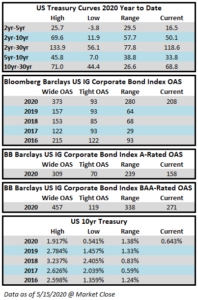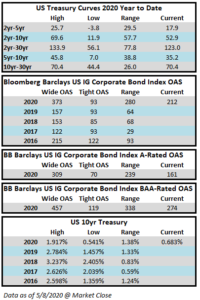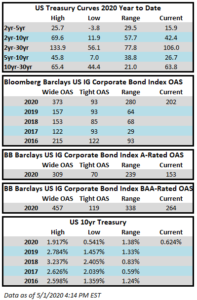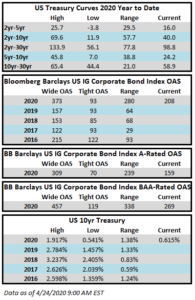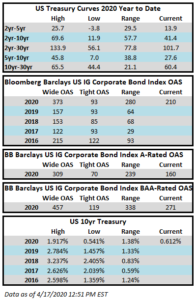Fund Flows & Issuance: According to a Wells Fargo report, flows week to date were +$5.2 billion and year to date flows stand at $11.3 billion. New issuance for the week was $8.3 billion and year to date issuance is at $134.0 billion.
(Bloomberg) High Yield Market Highlights
- S. junk bond issuance will likely slow ahead of the long weekend. More than $8 billion sold this week amid a rally that has seen spreads retreat to below 700 basis points for the first time since March.
- Average high-yield spreads have rallied 76bps since last Friday to 681bps over Treasuries, the lowest level since March 11, according to Bloomberg Barclays index data
- Investors are looking to past points of weakness as a possible guide to performance in coming months, according to Barclays Plc credit analysts led by Brad Rogoff
- “With corporate fundamentals likely to remain under meaningful pressure, we have an up-in-quality bias in the high yield market and prefer BBs,” they wrote in a note Friday
- Junk bond funds reported an inflow of $5.2 billion for week, the eighth straight week of inflows
- High-yield issuance is nearing $32b this month, making it the busiest May in five years. Seven deals for over $3 billion sold Thursday as borrowers rushed to clear the market before the Memorial Day holiday
- Junk bonds gained for the fourth consecutive session with returns of 0.4% on Thursday. Spreads fell 10bps to close at +681, still the lowest in 10 weeks. Yields dropped 14bps to 7.45%
- CCCs were the best performers on Thursday with returns of 0.69%. Spreads dropped 16bps to +1,309bps, a new 10-week low. Yields fell 15bps to 13.80%
(CNBC) Powell says GDP could shrink more than 30%
- The U.S. economy could shrink by upwards of 30% in the second quarter but will avoid a Depression-like economic plunge over the longer term, Federal Reserve Chairman Jerome Powell told “60 Minutes” in an interview aired Sunday.
- The central bank chief also conceded that jobless numbers will look a lot like they did during the 1930s, when the rate peaked out at close to 25%,
- However, he said the nature of the current distress coupled with the dynamism of the U.S. and the strength of its financial system should pave the way for a significant rebound.
- Asked by host Scott Pelley whether unemployment would be 20% or 25%, Powell said, “I think there’re a range of perspectives. But those numbers sound about right for what the peak may be.” Pressed on whether the U.S. is headed for a “second depression,” he replied, “I don’t think that’s a likely outcome at all. There’re some very fundamental differences.”
- In a part of the interview that did not air, Powell said shrinkage of U.S. economic growth “could easily be in the 20s or 30s,” according to a CBS transcript.
- “I think there’s a good chance that there’ll be positive growth in the third quarter. And I think it’s a reasonable expectation that there’ll be growth in the second half of the year,” Powell said. “I would say though we’re not going to get back to where we were quickly. We won’t get back to where we were by the end of the year. That’s unlikely to happen.”
(Bloomberg) Yields Over 10% Keep on Coming in Deeply Split Junk Bond Market
- The junk bond market has become no stranger to double-digit yields.
- S. Steel Corp. is the latest to join the crowd, marketing a $1 billion secured offering at 12% that may also be discounted to entice investors. Northwest Fiber is sounding out interest for $250 million of unsecured bonds at 10.75%, also with a discount, to help finance an acquisition. Cooper-Standard’s secured deal of the same size sold at a 13.664% yield.
- The junk bond market has rallied to an average yield of 7.6% from a peak 11.7% in March. But that number can be misleading. It’s so bifurcated that many companies actually borrow either substantially below that rate, or in these cases Thursday, much higher. On top of the big interest expense, several of the riskier companies, like U.S. Steel and Cooper-Standard, are also pledging valuable assets to turn over to creditors should they not be able to pay in cash.
- The quality of that collateral has become increasingly important since creditors balked at the aging fleet put up by United Airlines Holdings Inc. in its recent attempt to borrow. United ended up pulling the deal, unwilling to borrow at the higher 11% yield investors demanded than what was initially offered.
(Reuters) China move to impose security laws on Hong Kong
- Beijing is moving to impose new national security legislation on Hong Kong following last year’s often violent anti-China unrest that plunged the city into its deepest turmoil since it returned to Beijing rule in 1997.
- The introduction of Hong Kong security laws are on the agenda of the Chinese parliament which begins its annual session on Friday.
- The proposed legislation, which prompted concerns over freedoms in the semi-autonomous city, comes after large-scale and often violent pro-democracy demonstrations last year, which had already pushed some wealthy individuals to scout for investment options elsewhere.
- “In some cases where clients had a bit of inertia and hoped things that happened last year will just go away, they will now step on the gas to reduce their wealth concentration risk here,” said a senior banker at a European private bank.
- “In many cases last year, we saw our clients putting in place plan B and didn’t quite move the assets out of Hong Kong. I have already received some enquiries to activate that plan now,” said the banker, whose firm manages more than $200 billion in assets.
